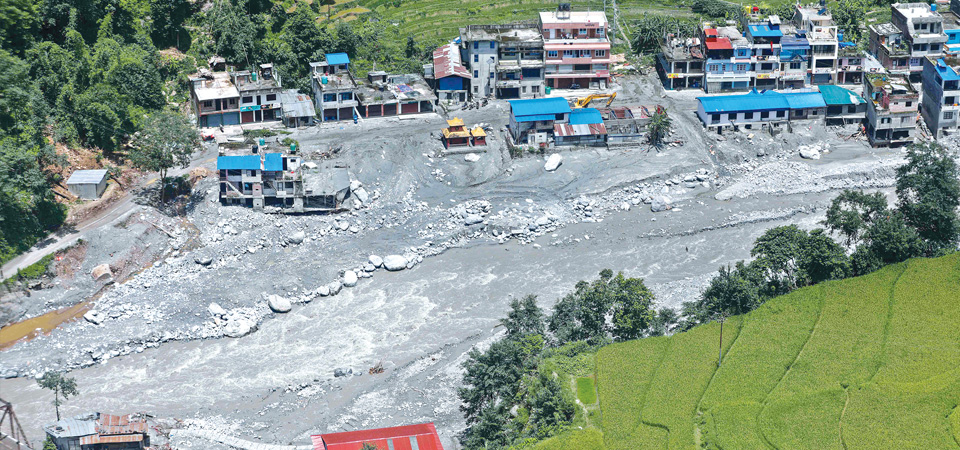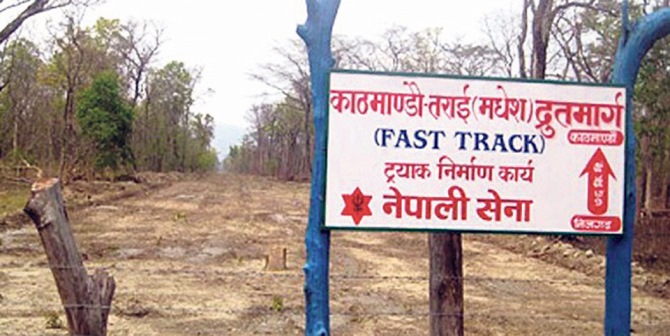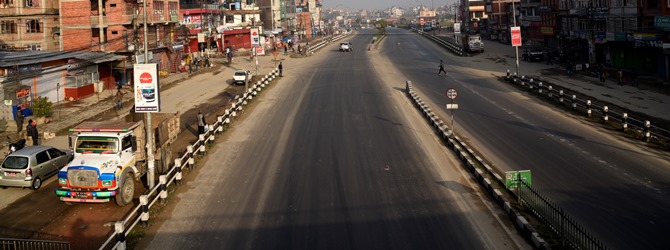Human error, fragile topography main reasons behind monsoon mayhem

By Purushottam P. Khatri
Kathmandu, July 11: Monsoon-induced disaster predominantly landslides and floods are common geological hazards triggered by torrential rainfalls during rainy season.
Within just 30 days of the onset of monsoon from June 11 this year in Nepal, 53 people were killed, over five dozen were injured and 53 other are still missing as of July 9, 2021. Normally, monsoon in Nepal last up to 105 days to retreat on September 23.
Dr. Ranjan Kumar Dahal, an engineering geologist and geo-hazard expert, said proper identification of landslides hazard mapping through geographic information system (GIS) would remain as one of the major tools that can support in minimising disaster risk.
Dr. Dahal, who specialises in landslide, debris flow and earthquake-risk research and management, said potential sites that are particularly prone to landslides should therefore be identified in advance to reduce disaster damages. Landslide hazard assessment can be a vital tool to understand the basic characteristics of the terrains that are prone to failure especially during extreme climatic events.
“Actually, landslides are one of the normal landscape building processes in the mountainous regions and they become a problem when they interfere with human activities,” Dr. Dahal said.
“Development of roads and other connectivity are not the blaming factor to show reason behind landslides in Nepal because we need these infrastructures, but the trend, approach and the wrong design which we are choosing are to blame the most,” Dr. Dahal said.
Associate Professor Dr. Subodh Dhakal at the Department of Geology in TU and geological engineer and disaster risk reduction expert, said the government’s poor preparation and execution part in preparing pre-monsoon preparedness plan has resulted in increased loss in human lives and properties.
“Our current development model does not factor in geological engineering and scientific surveys. Moreover, climate change is also causing more frequent and intense rainfall, triggering landslides in high hills and mountain regions,” he said.
Over 300 bridges at risk
There are about 2,000 concrete bridges on the main highways and 400 on the inner roads of the highways. According to the Bridge Division, under the Department of Roads, at least 300 old bridges need to be repaired or replaced immediately. Older bridges are more on the East-West Highway. Deputy Director General of the Bridge Division, Deepak Shrestha said 15 concrete bridges were damaged by the floods and three others by the strong winds this season. A seven-member task force has been formed under the coordination of Deputy Director General of the Bridge Division Shrestha to submit a report on the flood-damaged bridge within a month. The bridge division has not yet disclosed the damage.
Haphazard road construction
Road-construction is considered a major development indicator in rural areas of Nepal. Yet local road networks are cut haphazardly into steep hillsides with next to no planning, resulting in landslides, with massive amounts of soil being washed into rivers. The government agencies and contractors make use of dozers to cut roads in hilly areas. This loosens the soil, resulting in dry landslides even in the winter, said Dr. Dhakal. He said rush to build new roads is causing severe flooding in the Terai and significant destruction of forest cover, ecosystems and productive land across the country.
Environmentalist Prabhu Budathoki said if the current construction model is given continuity, not only will there be more landslides but the fertile land of hilly region will also be destroyed, seriously affecting agricultural productivity. Experts said the number of landslides and floods in Nepal began to tick up after 1994 when the central government increased development budget for local bodies.
“These local bodies in turn gave permission to carving roads without any study. Now, with the country adopting a federal structure, even more resources have been transferred to local governments, resulting in even more haphazard construction. Similarly, the federal government is building highways in various parts of the country without considering their environmental impact. Already, highway areas are prone to disasters,” said Dr. Dahal. “The pattern of water-induced natural disasters this year is entirely different to previous years. There is less flooding in Terai area but the number of landslides in hilly districts has significantly increased,” said Budathoki.
Relocation of vulnerable communities
“Landslides cannot be fully prevented but there are ways to secure people’s lives against them,” said Budhathoki. One way is identifying and relocating human settlements in hilly and mountainous areas vulnerable to landslides. NDRRMA (National Disaster Risk Reduction and Management Authority) had suggested relocation of vulnerable settlements but to no avail. Its study had identified around 11,000 houses in disaster-hit districts for relocation.
Reconstruction, rehabilitation approach
“The government for the rehabilitation purpose has adopted mainly two policies to address monsoon-related disaster. First is the relocation of risky settlements to safer places. Secondly, the disaster victims are to be provided with relief and rehabilitation amount to build houses in a safe place as per the wishes of the victims,” CEO Pokhrel said.
The government through the Cabinet decision held last year had decided to provide Rs. 300,000 to each family to build another house to replace the house damaged in the natural calamity. The Ministry of Home Affairs has stated that there is a policy of providing land to the landless families and giving additional Rs. 200,000 instead of the land if the victim does not want to stay in the government-arranged land.
CEO Pokhrel said that based on the last year’s decision, the NDRRMA had already sent Rs. 300 million to 22 various districts for the reconstruction and rehabilitation of flood and landslides victims.
And under immediate relief amount for this season’s monsoon, the NDRRMA has been providing Rs. 50,000 to each victim for the construction of temporary settlements and as of July 9, the government had dispatched Rs. 28.6 million in seven districts, CEO Pokhrel said.
In the part of early warning system, the government units under it have been doing great work in alerting and informing public about possible disaster and floods in advance. Several communication and information exchange and flood and landslide alert sirens have been installed in various locations, said CEO Pokhrel.
Monsoon casualties
In the last one week from July 2 to 9, landslides, flood and heavy rains killed 20 people, damaging 52 infrastructures and caused a loss of property worth Rs. 40 million. According to NDRRMA, between September 28, 2019 and September 28, 2020, in all 292 people had died in monsoon-induced disaster.
In the last five years, a total of 16,602 natural disaster incidents happened, in which a total of 2,466 people were killed and a property worth Rs. 14 billion was damaged. In addition, 16,609 livestock were killed. Parbat, Palpa, Gulmi, Sindhupalchowk, Myagdi, Lamjung, Jhapa, Dhading, Tanahu, and Gorkha are traditionally the most landslide-prone districts of Nepal. This is in addition to 14 districts surrounding Kathmandu Valley that were badly shaken by the 2015 earthquake.
As of July 9, 2021, 47 districts have already been affected from the water-induced disaster, according to NDRRMA.
Recent News

Do not make expressions casting dout on election: EC
14 Apr, 2022
CM Bhatta says may New Year 2079 BS inspire positive thinking
14 Apr, 2022
Three new cases, 44 recoveries in 24 hours
14 Apr, 2022
689 climbers of 84 teams so far acquire permits for climbing various peaks this spring season
14 Apr, 2022
How the rising cost of living crisis is impacting Nepal
14 Apr, 2022
US military confirms an interstellar meteor collided with Earth
14 Apr, 2022
Valneva Covid vaccine approved for use in UK
14 Apr, 2022
Chair Prachanda highlights need of unity among Maoist, Communist forces
14 Apr, 2022
Ranbir Kapoor and Alia Bhatt: Bollywood toasts star couple on wedding
14 Apr, 2022
President Bhandari confers decorations (Photo Feature)
14 Apr, 2022





.jpg)




